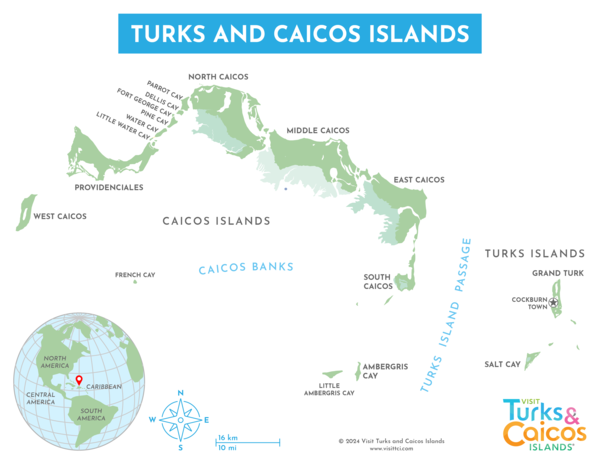Islands of the Turks & Caicos
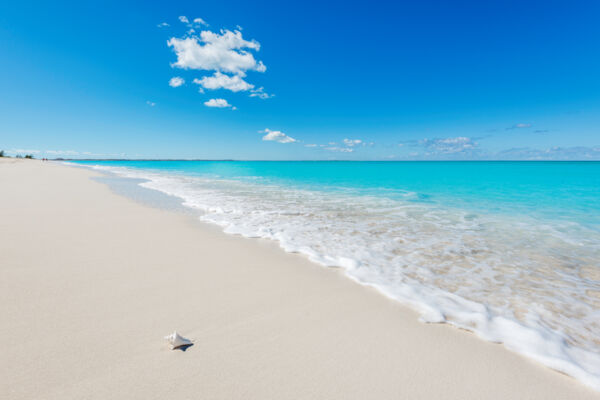
The Turks and Caicos has 40 main islands and cays. There are an additional 62 named very small cays and rocks. Nine islands in the Turks and Caicos are inhabited.
The inhabited islands in the Turks and Caicos, in order of population, are Providenciales, Grand Turk, North Caicos, South Caicos, Middle Caicos, Salt Cay, Pine Cay, Parrot Cay, and Ambergris Cay.
As the country name suggests, two island groups comprise the archipelago: the Turks Islands and the Caicos Islands. Compared to many other well-known Caribbean islands, the islands in the Turks and Caicos are quite small. The largest island at its widest length is Middle Caicos, with a span of about 16 miles (26 km), so driving distances are never great.
Turks and Caicos Location
The Turks and Caicos Islands are located in the Atlantic Ocean southeast of the Bahamas and north of the island of Hispaniola (which Haiti and the Dominican Republic share).
The Turks and Caicos is very easy to get to from most US east coast cities, with 90-minute flights from Miami and a little over three hours from New York. English is the official language here and the country uses the US dollar, so it’s very convenient to vacation here from the United States. All of the inhabited islands feature unique atmospheres, coastal environments, and historical perspectives. Accommodations range from large luxury hotels to a very wide collection of rental villas.
Inhabited Islands in Turks and Caicos

Providenciales
The island of Providenciales in the Turks and Caicos is home to the majority of the nation’s population, as well as Grace Bay and most resorts. Providenciales (or Provo as it’s commonly referred to as) leads in the number of spectacular beaches, with amazing Grace Bay Beach, the Bight Beach, Long Bay Beach, Leeward Beach, Sapodilla Bay, Taylor Bay, and many other coasts. Most water sports and boat charter companies are based on Providenciales, so if you’re looking to get some kiteboarding instruction or go fishing, this might be the right island for you.
Of the islands in the Turks and Caicos, Provo offers by far the widest range of luxury resorts, boutique hotels, rental vacation homes, restaurants, and shops.
Nearly all overnight guests staying in the Turks and Caicos arrive at Providenciales, as the Providenciales International Airport welcomes the vast majority of scheduled international flights. Island hops via yacht charter and scheduled domestic flights and ferries are typically quite quick.

Grand Turk
Grand Turk is the second-most populated and developed island in the country, and is home to our capital city of Cockburn Town and our only cruise ship port. The island once supported a thriving sea salt industry, and as the center of Government, there’s a great historical atmosphere. Old Colonial buildings line the oceanfront town, old salt industry walls and gates can still be seen in the shallow salina ponds, and the country’s only lighthouse, a smaller yet elegant cast iron example, stands on the far northern edge of the island overlooking North Reef.
The island had a population of 4,831 according to a 2012 census, but is probably between 5 and 6 thousand now. Grand Turk is very small at only 6.9 mi² (18 km²), and is only a little over 6 miles (9.8 km) across on its longest dimension.
Grand Turk is also renowned for its excellent wall scuba diving, where the barrier reef and underwater island plateau quickly drop from about 50 feet (15 m) to more than 3300 (1000 m). The vast majority of visitors to Grand Turk simply stop over for the day on a cruise ship port call. There are a few small hotels and villas which primarily cater to scuba divers, yet the island can be a great place to visit for its quaint atmosphere and quiet beaches.

North Caicos and Middle Caicos
North Caicos and Middle Caicos are the largest islands in the country, and are located in the center of the Caicos Islands archipelago. Both are connected by a road causeway, so they largely function as one island. The islands experience greater rainfall than our other islands, so the grass is really greener and the trees are taller on our Garden Islands.
North Caicos supports a population of under 2000 people (1,312 according to a 2012 census), and Middle Caicos is home to about 200. The landmass of North Caicos is about 45 mi² (116 km²), and Middle Caicos is 56 mi² (144 km²). A large proportion of this landmass consists of wetlands, tidal flats, and mangrove estuaries, much of which is protected in the Ramsar Nature Reserve.
North and Middle Caicos are exceptional for nature and outdoor-oriented vacations. Some of our most majestic coastlines and beaches are here, including Mudjin Harbour, the Crossing Place Trail, Bambarra Beach, and Sandy Point Beach. Land attractions include Conch Bar Caves, Wade's Green Plantation, Cottage Pond, and Flamingo Pond.

South Caicos
South Caicos, or the Big South as it’s often locally called, is the fishing capital of the Turks and Caicos. The island only has three resorts, yet it offers a unique experience in that it’s largely untouched by tourism development and is surrounded by an exquisite marine environment.
South Caicos is great for off the beaten track outdoor vacations. There’s exceptional bonefishing and bottom fishing, kayaking, paddleboarding, and kiteboarding, and many incredible uninhabited cays to explore, including Long Cay, Fish Cay, and the channel islands to the north.
South Caicos has a landmass of about 8.2 mi² (21 km²), let much of this consists of the central salt ponds and salinas that were once worked to produce sea salt for export. The island’s population is 1,139 as recorded in a 2012 census, and the only settlement is Cockburn Harbour, located on the southwestern coast.
American Airlines operates a twice-weekly Miami—South Caicos (XSC) flight to the island. Regular domestic flights to South Caicos are available from Providenciales.

Salt Cay
The small Salt Cay is located in the Turks Island group on the eastern side of the Turks and Caicos, and has a collective area of about 2.6 mi² (6.7 km²). There are approximately 100 permanent residents on the cay, which creates a very close-knit community. As its name suggests, Salt Cay once was a major sea salt producer, at which time the island was a bustling place. Times have changed, and the opposite is true today. Not much happens, which make the cay a very quiet vacation destination.
Tourism largely revolves around scuba diving and humpback whale watching, yet there are some amazing and secluded beaches and coasts to discover. All accommodations are rental villas or homes.

Parrot Cay
Parrot Cay, located in the string of cays between Providenciales and North Caicos, is a private island retreat that’s famous for long being a vacation escape destination for the rich and famous. The accommodation on the cay includes many opulent rental vacation villas and the exclusive COMO Parrot Cay Resort.
Parrot Cay doesn’t have an airport, so all scheduled transport to the private island from elsewhere in the Turks and Caicos is via small passenger ferry boats, which are operated by the resort. The island has a beautiful beach on its northeastern end, where the conclusion of Parrot Cay Channel, the waterway that separates the island from North Caicos, meets Sandy Point Beach. At low tide, it’s possible to wade over to North Caicos across the sandbars and shallows.

Pine Cay
Pine Cay is a private cay gem near Providenciales, and has one of the nicest beaches in the Turks and Caicos. The island is largely home to vacation homes, yet one small hotel, the Pine Cay Resort, is found here. This boutique getaway offers seclusion and an upscale atmosphere while still being quite laid back.
Pine Cay is located about 10 minutes away by boat from Providenciales. There’s a small airstrip on the island as well, yet the ferry service is fast and comfortable, so most visitors opt to go by water.

Ambergris Cay
Ambergris Cay is a bit of an outlier in the Turks and Caicos. The cay is a private island located on the remote southeastern edge of the Caicos Islands, so the atmosphere is more in line with Parrot Cay and Pine Cay than it is with our main islands.
The terrain and coastlines of Ambergris Cay is a bit more rugged than many of our other islands, as they are exposed to the constant eastern trade winds and the swell and waves of the ocean. The island supports many of our unique and endemic animals, including the largest existing populations of our rock iguana, as well as our miniature boas, geckos, and small lizards. Close to Ambergris Cay is Little Ambergris Cay, an amazing nature reserve island of wetlands, beaches, and sandbar systems.
Ambergris Cay Resort, which is part of the Turks and Caicos Collection group of resorts, manages a small upscale resort and the island’s rental properties. Transit to the island is primarily via small private aircraft, which typically operate between one of the private FBOs at the Providenciales International Airport and the Harold Charles (HBAC) Airport on Ambergris Cay.

Small Islands and Cays
The Turks and Caicos has over 100 named islands and cays. Many are quite small, yet they’re all beautiful places to explore! Some of our uninhabited islands have become attractions due to their secluded beaches, sandbar systems, snorkeling, wildlife, and historical sites.
Only two large islands in the Turks and Caicos, East Caicos and West Caicos, are not inhabited. Both offer fascinating history and breathtaking landscapes.
Some spectacular cays in the Turks and Caicos include the Turks and Caicos Islands rock iguana sanctuary of Little Water Cay, Water Cay with its exquisite beach, the stingray haven of Gibbs Cay, the nature reserve of Little Ambergris Cay, and the eco-destination of Mangrove Cay.
One of the best things to do in the Turks and Caicos is to explore the islands via a yacht charter. There’s so much waiting to be discovered.
What the Turks and Caicos Offers
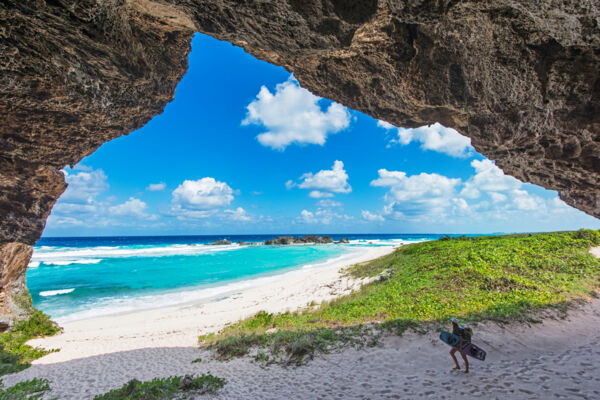
You should first ask yourself what you’re looking for in your Caribbean holiday. The appeal of the Turks and Caicos Islands is our spectacular beaches, a pristine marine environment, beautiful reefs, and excellent places for water sports.
If you’re looking for a relaxing time at the beach, you cannot do better than the Turks and Caicos. Grace Bay Beach on Providenciales is of course famous, but almost all of our islands and cays have really beautiful white sand beaches.
Due to the extensive barrier reef and impressive walls, diving throughout the Turks and Caicos is spectacular. Providenciales offers a great selection of dive shops and access to exceptional sites, yet Grand Turk, Salt Cay, and South Caicos all have scuba dive shops, and offer a different perspective as they’re off the beaten track.
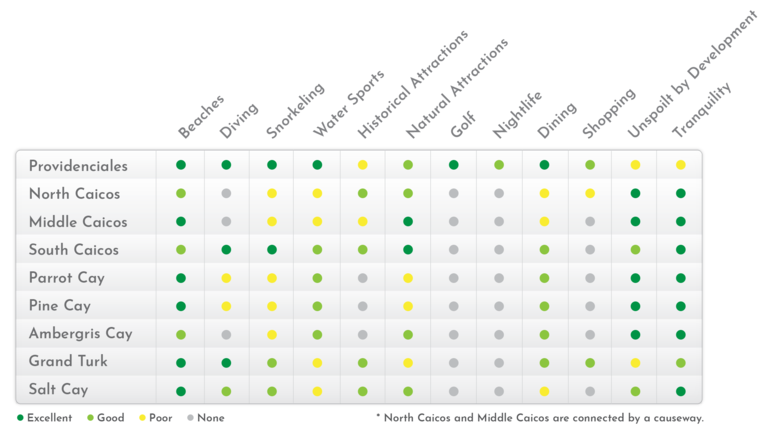
Which Island is the Best for You?
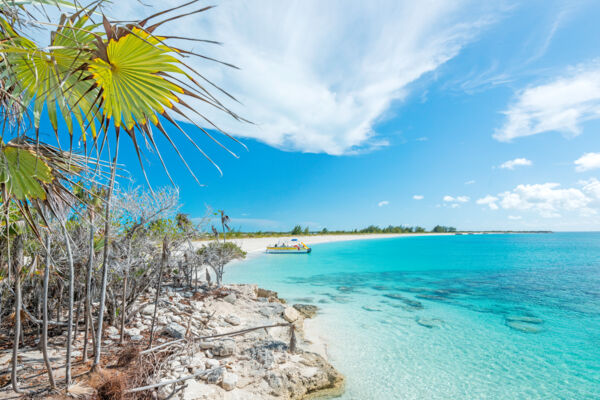
The different islands in the Turks and Caicos each bring something unique to the table. Providenciales is of course the center for beaches, luxury resorts, fine dining, marinas, and shopping. It’s also the place to be for most water sports and activities, such as snorkeling, kiteboarding, parasailing, and boat cruises. The majority of the population in the country lives here and nearly all scheduled international flights land at the Providenciales International Airport (PLS).
Home to the capital of Cockburn Town, up until the last few decades Grand Turk has been the center of activity in the Turks and Caicos. The country’s only cruise ship port is found here, along with the best historical attractions, including the Grand Turk Lighthouse, Turks and Caicos National Museum, and H.M. Prison.
The wild North Caicos and Middle Caicos offer a different perspective. The greenest islands in the country, plantations here once exported cotton and sisal. Today, a quiet atmosphere, vast undeveloped land, secluded and impressive coastlines, and great natural points of interest are the main draws. Small vacation rentals make up most of the accommodation options on these two islands.
Often overlooked, the quiet Salt Cay and South Caicos offer visitors the chance to experience the Caribbean untouched by tourism. These little islands have both had a lucrative past producing sea salt for export, but have seen declining economies since the end of the industry in the early 1900s. There’s a lot of sand beach and coastal scenery to explore.
Why not the Turks and Caicos Islands?
If you’re looking for casinos or nightlife, you would be better off visiting Las Vegas or another Caribbean destination. There are few casinos and nightlife options, so you would probably be disappointed.
